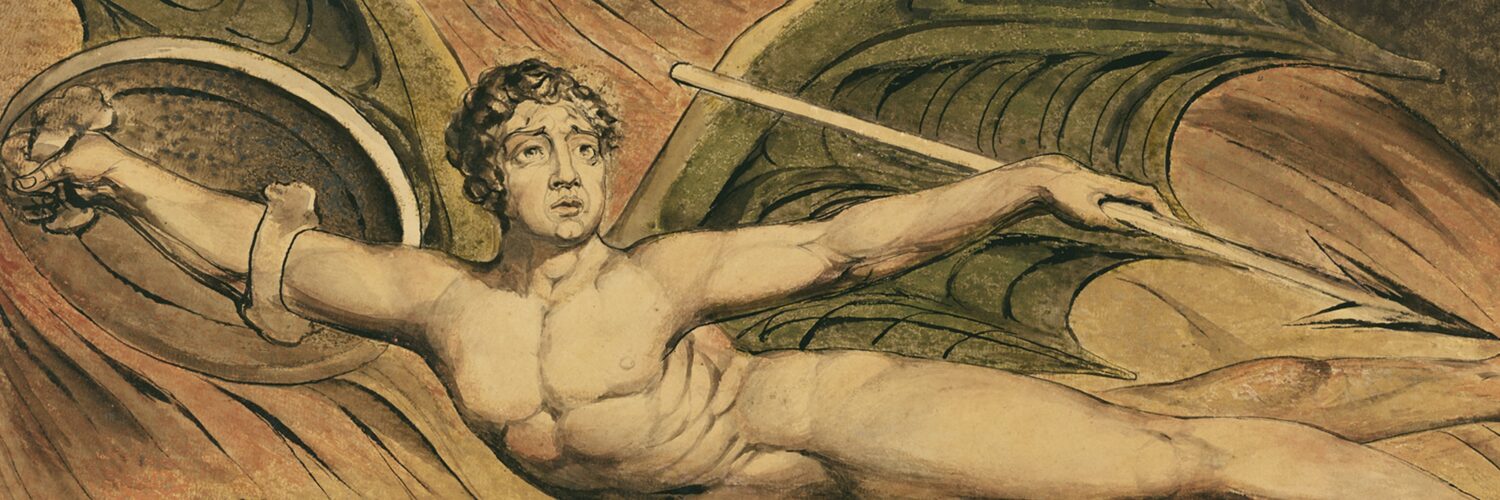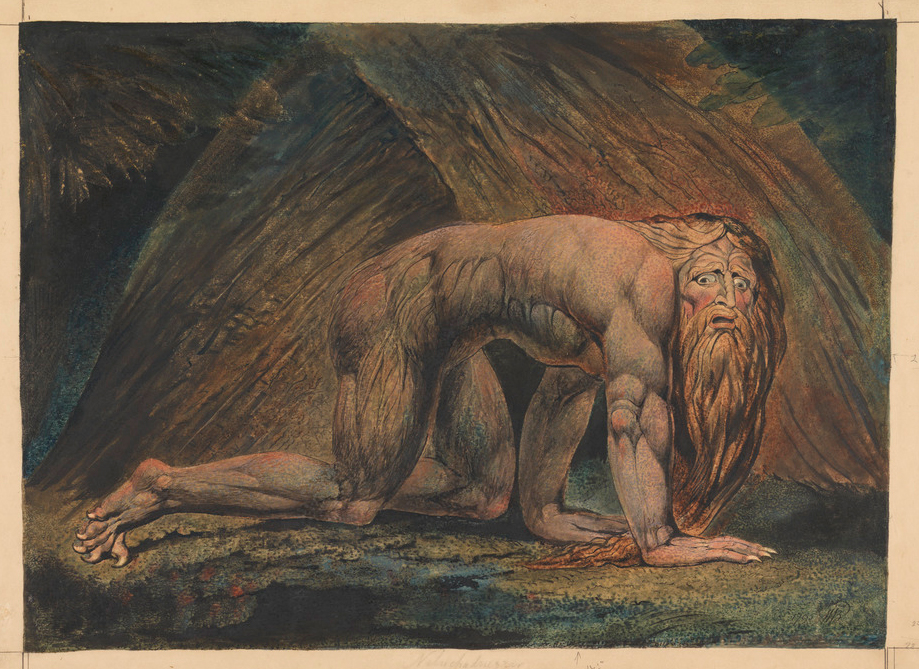
English poet, painter, and printmaker—a remarkable artist, William Blake (1757–1827) was singular in his preoccupations. Largely unrecognized during his lifetime, William Blake is now considered a seminal figure in the history of the poetry and visual art of the Romantic Age.
An artistic and intellectual movement that originated in Europe towards the end of the 18th century, the Romantic Age was at its peak from approximately 1800 to 1850 in most parts of Europe. Romanticism was characterized by its emphasis on emotion and individualism as well as glorification of the past and nature, preferring the medieval to the classical. Romanticism was partly a reaction to the Industrial Revolution, and the prevailing ideology of the Age of Enlightenment, especially the scientific rationalization of Nature.
Pictured above: Nebuchadnezzar, 1795-about 1805, William Blake. Color print with ink and watercolor. Tate, London. Presented by W. Graham Robertson 1939. Photo © Tate.
Now on view at the Getty Center, through January 14, 2024, William Blake: Visionary follows Blake’s journey as an artist, from his early years as a commercial printmaker to the legendary creator we know today. The exhibition is rich with artworks that explore Blake’s wild imagination through some of his most acclaimed pieces; many are from the Getty‘s own collection as well as local collections, while numerous works are on loan from the Tate in London. From fantastical beasts to otherworldly characters, William Blake: Visionary presents the artist’s wildly unconventional creations that sprang from his fertile imagination, some even inspired by hallucinations.
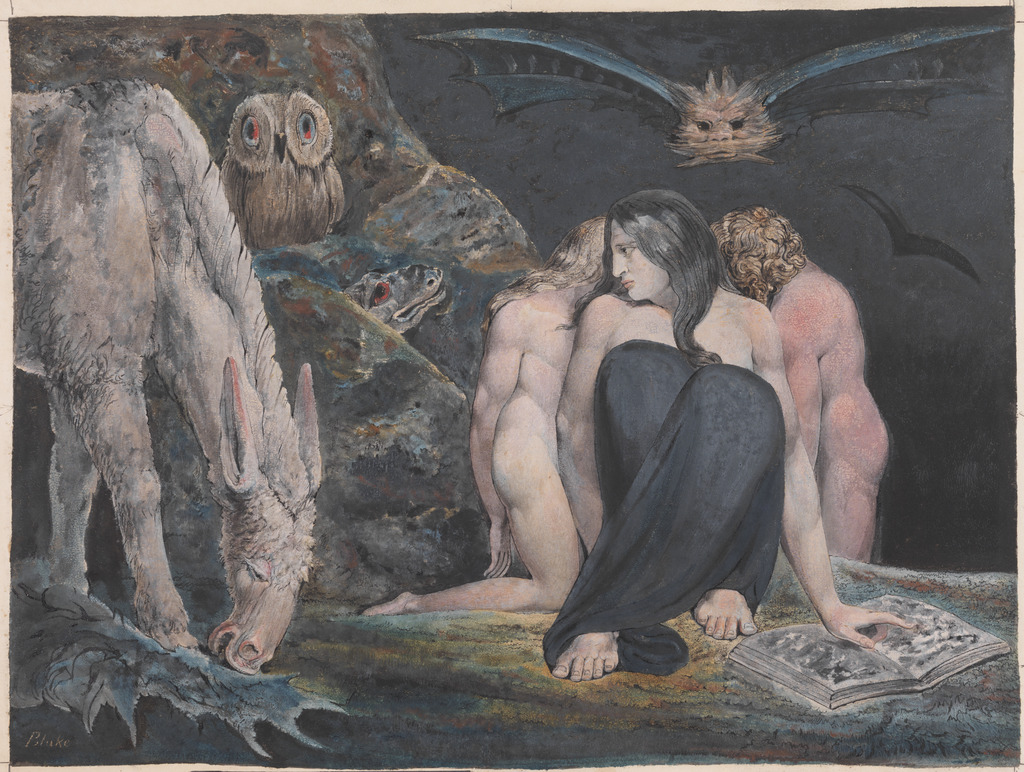
Organized by the J. Paul Getty Museum in cooperation with Tate, William Blake: Visionary was curated by Edina Adam, assistant curator of drawings at the Getty Museum and Julian Brooks, senior curator of drawings at the Getty Museum. Adam and Brooks also co-authored William Blake: Visionary, the richly illustrated accompanying book published by Getty Publications, featuring an essay by Matthew Hargraves.
Curator Edina Adam: “William Blake: Visionary was prepared in collaboration with Tate and the exhibition brings together about 110 pieces, including extremely generous loans from the Huntington Art Museum and library, Yale Center for British Art and a local private collector.
“William Blake hardly requires an introduction; many of you probably know him as a writer, as the author of the poem The Tyger. Others might be familiar with his striking imagery as a visual artist. What this exhibition sets out to do is to present these various aspects of his oeuvre and show how they all come together in his so-called ‘prophetic books.’ In these ‘prophetic books,’ William Blake used his own personal mythology to respond to political events that took place during his life. He engaged with themes such as political oppression, social injustice, and even self discovery. Once you go to the gallery, you will see the incredible loans that we managed to bring together for this exhibition.”
A significant artifact, the exhibition displays one of the finest colored copies of Blake’s illuminated book, America a Prophecy, which retells the story of the American Revolution. Views of the American Revolution differed greatly among the British: some considered it a rebellion while others, including Blake, deemed it justified opposition to tyrannical rule—a viewpoint that would have resulted in persecution if not for his use of invented characters.
Explains Edina Adam: “We’re extremely fortunate to have the entire set of America a Prophecy on view, which is William Blake’s version or his take on the American Revolution. And I encourage all of you to engage with this object because it’s extremely rewarding. We also have Ghost of a Flea up in the galleries, which is a very small scale painting of this monstrous creature that reportedly appeared to William Blake, in a vision. A testament of Blake’s talent as a printmaker, there are also some of his best large color printed drawings.”
Also on view are a few exquisite color impressions from Songs of Innocence and of Experience, the book by William Blake.
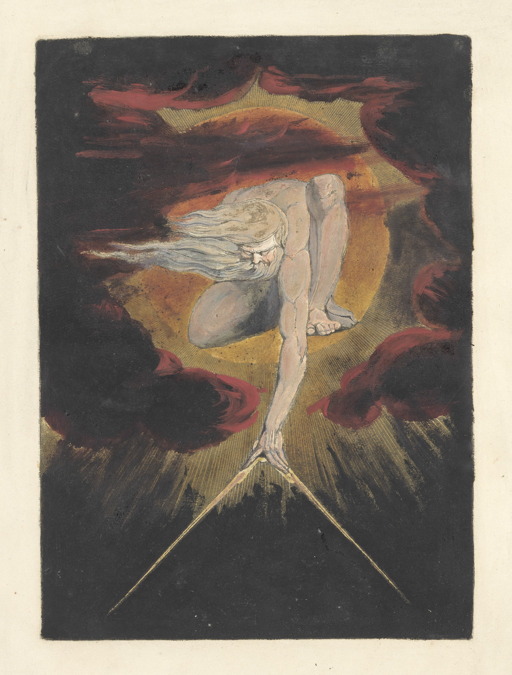
Visitors to the exhibition are encouraged to use the magnifying glasses available in the galleries, as some of the works and illustrations are minute. Containing immense detail, they reward close examination.
Director of the J. Paul Getty Museum, Timothy Potts‘ remarks: “Blake was such an extraordinary artist. And this exhibition is different from everything else that you might have expected. He was a very English phenomenon around which American industry of artistic literary and theological commentary interpretation has arisen.”
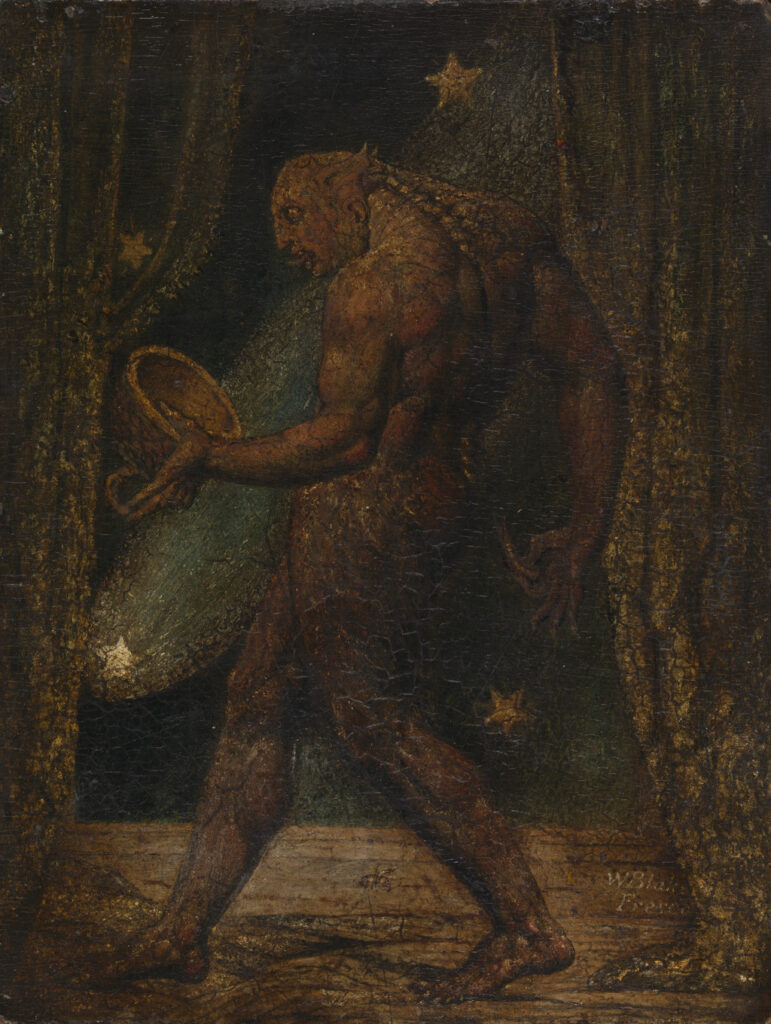
From the press release: William Blake developed a wildly unconventional world view, representing universal forces of creation and destruction—physical, psychological, historical—through his own cast of characters. By combining his poetry and images on the page through radical graphic techniques, Blake created some of the most striking and enduring imagery in British art history. This major international loan exhibition explores the artist-poet’s imaginative world through his most celebrated works.
This exhibition features over 100 striking works by the English printmaker, painter, and poet, William Blake. On view at the Getty Center from October 17, 2023, through January 14, 2024, this is the first major international loan exhibition of Blake’s work on the West Coast.
The exhibition begins by illustrating how Blake first honed his technical skills as a printmaker in London—his main source of income throughout his career. Eager to establish himself as an independent artist, he enrolled in the Royal Academy of Arts in 1779 but never achieved success. While audiences preferred literal renderings of beloved texts, Blake opted for more imaginative interpretations of his sources. And, while oil painting was considered the highest art, Blake chose to work in tempera, watercolor, and through printmaking.
In the 1790s, Blake started receiving commissions to design and engrave some of his own compositions. In 1793, he proudly claimed to have invented a new printmaking technique of relief etching which allowed him to effectively combine poetry and image together on a single page. He began exclusively publishing his own illustrated poetry, which he referred to as “illuminated books.” Pages from his most celebrated illuminated books, Songs of Innocence and Songs of Experience, are featured in the exhibition, including one of his best-known verses, The Tyger.
Blake often represented figures from the Bible and classical Greek and Roman mythology, along with allegorical characters from his own imagined universe that personified a myriad of emotions, behaviors, and concepts. A few invented figures that appear in his work include “Albion,” who generally represents England and fallen humankind, “Urizen” who often depicts tyranny and oppression, and “Orc” who embodies defiance and revolution.
Complementing the exhibition is an augmented reality experience, United Visions, created by Australian artists Tin&Ed and available for free download in the App Store. The Getty Center will also host a free lecture, William Blake and India, on Sunday, November 12, 2023.
William Blake: Visionary is organized by the J. Paul Getty Museum in cooperation with Tate. This exhibition is presented in English and Spanish. Esta exhibición se presenta en inglés y en español.
Make free advance reservations for the Getty Center.
Getty is a leading global arts organization committed to the exhibition, conservation, and understanding of the world’s artistic and cultural heritage. Working collaboratively with partners around the globe, the Getty Foundation, Getty Conservation Institute, Getty Museum and Getty Research Institute are all dedicated to the greater understanding of the relationships between the world’s many cultures. The Los Angeles-based J. Paul Getty Trust and Getty programs share art, knowledge, and resources online at Getty.edu and welcome the public for free at the Getty Center and the Getty Villa.
The J. Paul Getty Museum collects Greek and Roman antiquities, European paintings, drawings, manuscripts, sculpture and decorative arts to 1900, as well as photographs from around the world to the present day. The Museum’s mission is to display and interpret its collections, and present important loan exhibitions and publications for the enjoyment and education of visitors locally and internationally. This is supported by an active program of research, conservation, and public programs that seek to deepen our knowledge of and connection to works of art.
Visiting the Getty Center:
The Getty Center is open to a limited number of visitors, in accord with state and local public health guidelines, Tuesday through Sunday, 10 a.m. to 5 p.m. It is closed Mondays, Thanksgiving, December 25 (Christmas Day), and January 1.
Admission to the Getty Center is always free, but in order to allow social distancing, a reservation is currently required for admission. Reservation are available at www.getty.edu/visit or at (310) 440-7300. Parking is $20. The Getty Center is at 1200 Getty Center Drive, Los Angeles, California.
Additional information is available at www.getty.edu. Sign up for e-Getty at www.getty.edu/subscribe to receive free monthly highlights of events at the Getty Center and the Getty Villa via e-mail, or visit www.getty.edu for a complete calendar of public programs.


